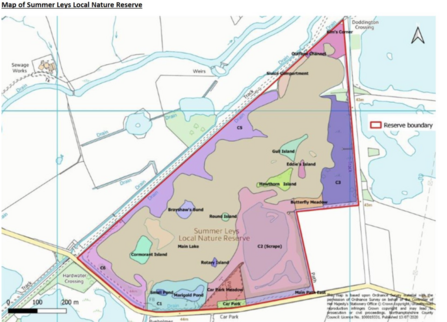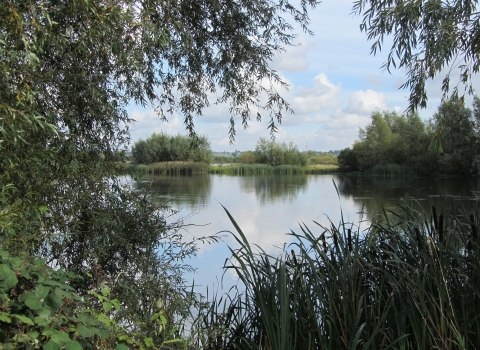The upcoming scheduled works will be on two of the islands plus the installation of a cattle pen and fencing, with some work in July and the rest in September.
Hawthorn Island
Hawthorn Island is close to the centre of the reserve in the heart of the primary habitat for waterbirds - see map below. The island is currently covered with slim willow trees around the perimeter, and primarily low hawthorn scrub in the interior. This area is out of character with the core wetland habitat around it, and the presence of trees and scrub can deter waterbirds from nesting, feeding or roosting close to Hawthorn Island. The trees have allowed shelter and perches for a range of waterbird chick and egg predator species, such as corvids.
The Trust have secured funding from Natural England, as part of the multi-year Summer Leys stewardship agreement, to clear Hawthorn Island of trees in September 2021. This will create a bare habitat, suitable for a range of wintering, roosting and breeding waterbirds. The island sits slightly higher than the adjacent islands, providing an additional range of habitat, and high-water roosting areas.
We do not undertake any clearance of trees and scrub lightly, but we - and Natural England - believe that this work will enhance the site for core designated waterbird species. We have undertaken an ecological survey of Hawthorn Island to ensure that the clearance work will not compromise any protected species and are satisfied that the work will not cause significant issues. Hawthorn Island has been used by otters in the past, although no evidence of any otter holt was found and otter activity is known to be frequent in other parts of Summer Leys. The island has also been used for illegal fishing activities, and a substantial fishing camp found on the Island recently - this will be removed prior to clearance work taking place.
The loss of any kind of trees from a nature reserve can cause mixed views, but we are confident that the benefit to core designated waterbirds is significant. We continue to work to enhance the scrub sections of Summer Leys to attract a wide range of bird species to the site.
The work to clear Hawthorn Island will consist of the construction of a temporary causeway between the Scrape compartment and Hawthorn Island, and then clearance of the island itself. We have planned the work to take place during periods that minimise the disturbance to protected bird species, and the inconvenience to visitors: we have liaised with Natural England regarding the timing of work.
The main clearance work is planned for early September 2021 and will take one to two weeks to complete: this time of year minimises impact on our waterbird populations, avoiding key breeding and core winter periods, and means work will take place when water levels are low, increasing work safety. Work to construct the causeway to Hawthorn Island therefore needs to take place eight weeks earlier, in order to allow time for the constructed causeway to settle and be safe to accommodate the heavy machinery that will be using it for the clearance work. This means that the causeway construction, which will take up to five days, will occur in early July. The work will consist of two machines and operators and we hope it will not cause high levels of disturbance. We are aware that this timing is not ideal, as it will be the tail end of the bird breeding season but, on balance, have concluded this is the best available option for the work. We hope that by this time most chicks will be mobile and that any disturbance this year will be mitigated by the increased breeding habitat in subsequent years.
We will update in due course regarding exact timing of this work.


